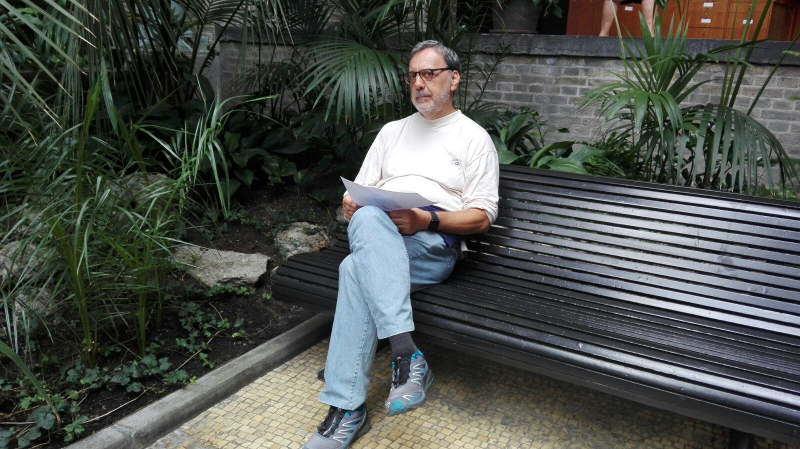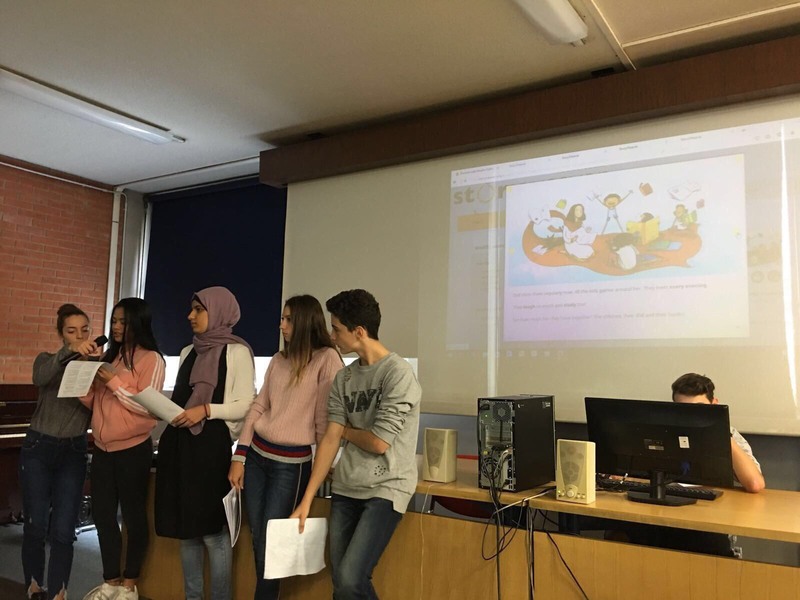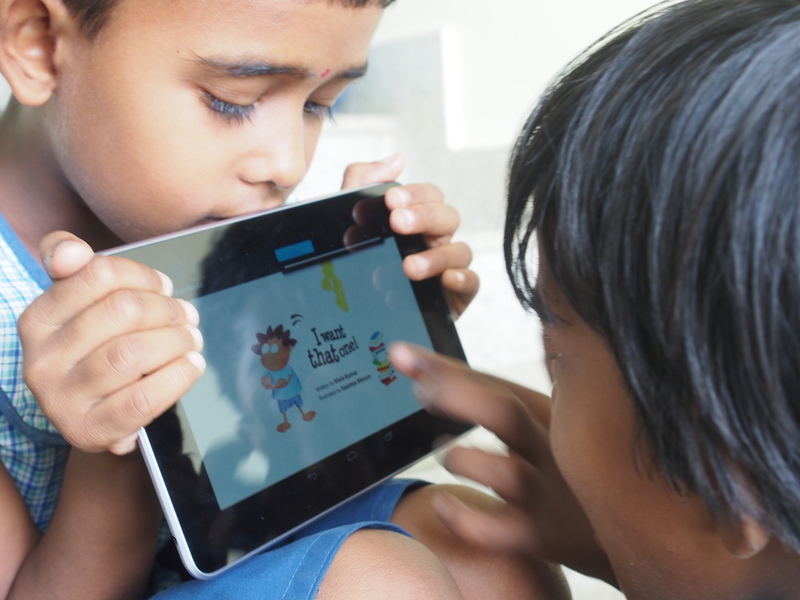Meet our community: Roberto Marcolin
Posted by Remya Padmadas on March 06, 2018
Roberto Marcolin is a High School teacher near Milan, Italy. He’s been doing some very interesting things with StoryWeaver both inside the classroom and out! Read on to find out more.
“I’m a teacher in a high school near Milan, Italy and I'm in charge of the school library. Our school recently participated in Libriamoci a Ministry of Education project to promote reading aloud. Many different classes in the school took part, with some students reading out loud stories from StoryWeaver in English. At the end of January, we took part in Piazze Solidali (Solidarity Squares), an event held in the public library of our city. At the event some of my students read StoryWeaver stories in six different languages: Albanian, Romanian, Arabic, Spanish, French and of course Italian."

A class from Roberto's school is participating in Etwinning a European project, students from the Czech Republic, Spain and Sweden. "Through this project they will translate books from English to their mother tongue on StoryWeaver. You can find the first seven stories translated to Italian on StoryWeaver."
Students read aloud stories from StoryWeaver at the Libriamoci event held in October, 2017.
Roberto has also made an audio version of ‘Ghum Ghum Gharial’s Glorious Adventure’ in Italian with Canoprof an open source software created by the French education ministry.
“Framapad is an open source software for collaborative writing which I used when preparing for the Piazza solidale event. I made some recordings of stories like this one and I hope to do others. I think they could be used to promote reading amongst students.”
Roberto has a few other ideas on how he would like to use StoryWeaver. “In 2018, I would like to organize a collaborative translation of some stories of StoryWeaver involving other teachers and students. The translators could meet in a place at school like the library and collaboratively translate some stories together. I would also like to create free digital libraries using StoryWeaver stories as my French colleague Cyrille Largillier has already done here.”
We look forward to hearing more from Roberto and his students this year!
If you are using stories in your classroom or library and would like to share it with our community, write to us at [email protected] and we’ll feature you on our blog!
Be the first to comment.Pratham Books is looking for a Content Manager for its Digital platform
Posted by Remya Padmadas on February 14, 2017This position has been filled! Do keep following us on Social Media for updates on other job openings.
You’re reading about this position because you believe in the power of content - good content. Similarly, at Pratham Books, we believe in the power of stories – good stories. For well over a decade we have strived hard to reach children across India with a variety of award-winning stories across 18 Indian languages. With our digital crowd-sourcing platform – StoryWeaver we now share the power of stories with a global community of educators, parents, authors, illustrators and translators.

About the role
Pratham Books is looking for a dynamic individual for the position of Content Manager (StoryWeaver). A self-motivated individual with experience and skills in curating content from multiple sources, forging strategic partnerships and anchoring the process of migrating content to the platform. The person will lead a team and be responsible for timely execution to expand the content available on the platform to serve the needs of children globally. The role will report to the Head of Digital Initiatives and will work closely with different internal and external stakeholders. This is a full time position based out of Bengaluru.
The individual will be responsible for all the following
Strategic Partnerships
- Create partnership opportunities with other publishers to open license their content on the platform
- Create partnership opportunities with Indian Universities and Language Institutes to increase the pool of good quality translations on the platfor
- Identify and forge partnership opportunities with international organizations like Translator without Borders to nurture translation partnerships in International language
- Working closely with the content team for sourcing children's stories under open licences from across the globe
Programme Management & Design
- To build a strong cohesive programme operations team including setting up the Studio department and putting the processes and work-flows in place
- To ensure that we meet our commitments to donors, delivering projects on time and on budget, and delivering the committed activities and project reports in compliance with the project design
- To work closely with all stakeholders to ensure high quality standards are met for crowd-sourced content - including review processes and red flagging of inappropriate content
- To take on other tasks or responsibilities, as required for the project
- Archiving and documentation
Content Migration
- Prioritizing the pipeline of content from all sources for migration
- Managing the studio teams for the timely delivery of large scale data migration
- Working closely with the design teams to define new design templates
- Work with the technology partners to develop efficient processes for content migration
Liaison with co-collaborators & internal stakeholders:
- Creating a database of content creators, authors, illustrators, translators, etc on the platform to enhance engagements
- Work closely with the marketing team to come up with interesting promotions to promote use of content
- Work closely with the content, research and marketing teams to deliver the project goals
Required Skills
- Post graduate in Literature / Communication / Journalism with 7-10 years of experience in related fields. Experience with a publishing house is favourable.
- The candidate must have experience working in an editorial position in a publishing house and should have hands-on experience in review, proofreading and production related processes.
- Exceptional communication skills
- Highly organized and detail oriented
- A proven track record to manage, lead and deliver large-scale operations
- Proven ability to build consensus and work effectively within a cross-departmental team
- Self-starter, team player, strategic thinker and all around book nerd
- Passion, integrity and energy!
Nice to have but not mandatory
- Experience working with non-profits.
- 1-2 years working in a partner facing role
- Indic language and digital publishing experience
Location: Position is based out of Bangalore and is full-time.
Salary: Will be commensurate with experience. We are looking for a passionate individual who wants to be part of a team that is creating a new model in multilingual publishing to address the scarcity of books for children in need.
Interested candidates can email their resume to [email protected]
Be the first to comment.A day of celebrations: StoryWeaver turns two this International Literacy Day
Posted by Remya Padmadas on September 08, 2017September is a special month for us at Pratham Books, especially September 8th! International Literacy Day, not only marks our annual storytelling event One Day, One Story, but it is also the day StoryWeaver was launched.
When we launched, our goal was to create a participatory framework where content creators and users could collaborate with each other to create joyful reading material in multiple languages. We believed this would have a multiplier effect to address the scarcity of multilingual reading resources that exists in India.
The last two years have been an amazing journey. When StoryWeaver was launched, we offered 800 stories in 24 languages. Today, the platform is a buzzing hub of over 4700 in 91 languages. What makes StoryWeaver a truly special place though is our community. The authors, illustrators, translators, editors, art directors, teachers, librarians, literacy organisations and parents who are helping Pratham Books strive towards our mission of 'a book in every child's hand.'
It's the stories, videos and photographs from these passionate and committed folks that keep us going. Non-profits like Suchana and the Azad India Foundation, translating stories to tribal languages and dialects for the children they work with. Organisations like Pragat Shikshan Sanstha, Tamarind Tree and Akanksha curating reading lists and creating digital libraries for teachers and students. Edtech companies like mGuru who gamify our content for mobile learning apps, and Bookshare who is creating audio and braille books for print impared students. These are just a few examples of the amazing things openly licensing content can achieve. And how can we not mention the many individuals who are creating magic on the platform every day with the stories they create and translate?
To each of you who are a part of our community, a big, big, big THANK YOU!
Here's to more stories, in more languages, reaching more children!
Be the first to comment.